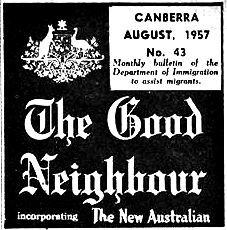Good Neighbour Council
The Good Neighbour Council was an Australian Commonwealth Government program launched in 1950 to win public acceptance of mass immigration of post-Second World War refugees and settlers by promoting rapid assimilation. State Good Neighbour Councils (GNCs) were formed to activate, encourage and co-ordinate the efforts of local church and community organisations in this role.[1]
History

The Good Neighbour movement was formally launched at the first Commonwealth Citizenship Convention in January, 1950. From their inauguration, the Councils influenced the Australian community towards a wider acceptance of the immigration programme and enlisted the community's support in the work of the integration of new settlers.[2]
There were Good Neighbour Councils in each State and Territory which successfully enlisted the active support and co-operation of some 960 community agencies and thousands of Good Neighbour volunteers to assist in migrant integration. The Council itself became a focal point for the training of volunteers and for information and direct assistance to migrants, holding seminars on the recognition of qualifications and welfare entitlements. The Council held art exhibitions and other events to celebrate ethnic origins and talents and prepared publications for settlers and volunteers.[3]
In 1950, Australian Government sponsorship of the Councils amounted to $16,000 with a staff of three, expenditure increasing in 1972 to $620,000 with a staff of 70. As well as head offices in each capital city, there were ten regional offices and five sub-offices established to bring the services available through the Good Neighbour Councils to areas of high migrant population. These offices were supported in their work by 2,187 branch members and 550 representatives of the Councils.[2]
The Council saw itself as distinctively Australian, stubbornly resisting meaningful migrant participation. Migrant groups and academics criticised this narrow assimilationist approach and alleged that the English-speaking staff failed to reach beyond British migrants.[1]
As the concept of multiculturalism replaced those of assimilation and integration, ethnic groups sought direct funding and on the recommendations of the Galbally report[4] the Councils were abolished in 1978,[1] though branches still continue in some states.[3]
See also
Notes and references
- 1 2 3 Jacqueline Templeton. "Good Neighbour Council". Retrieved November 30, 2012.
- 1 2 Department of Immigration and Multicultural Affairs. "Achievements of the Good Neighbour Movement 1949–72" (PDF). Retrieved November 30, 2012.
- 1 2 Gillian Winter. "Good Neighbour Council". Retrieved November 30, 2012.
- ↑ Australia. Review of Post-arrival Programs and Services to Migrants; Galbally, Frank, 1922- (1978), Migrant services and programs : [report of the Review of Post-arrival Programs and Services for Migrants], Australian Government Publishing Service, ISBN 0642036683